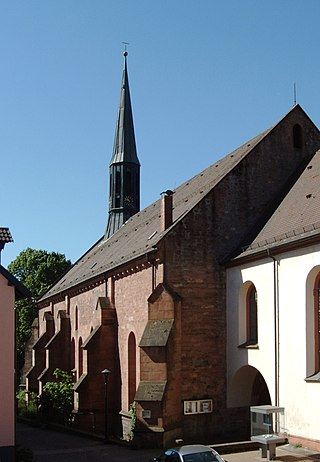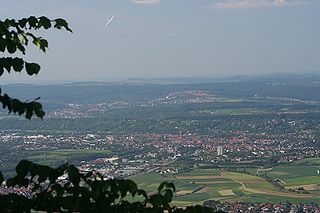
Baden-Württemberg, commonly shortened to BW or BaWü, is a German state in Southwest Germany, east of the Rhine, which forms the southern part of Germany's western border with France. With more than 11.07 million inhabitants as of 2019 across a total area of nearly 35,752 km2 (13,804 sq mi), it is the third-largest German state by both area and population. As a federated state, Baden-Württemberg is a partly-sovereign parliamentary republic. The largest city in Baden-Württemberg is the state capital of Stuttgart, followed by Mannheim and Karlsruhe. Other major cities are Freiburg im Breisgau, Heidelberg, Heilbronn, Pforzheim, Reutlingen, Tübingen, and Ulm.
The Zollernalbkreis is a Landkreis (district) in the middle of Baden-Württemberg, Germany. The district is located in the Swabian Alb, and contains the second highest elevation of this range, the 1,011-metre (3,317 ft) high Oberhohenberg. In the south-east the district nearly reaches to the river Danube.

The Bundschuh movement refers to a series of localized peasant rebellions in southwestern Germany from 1493 to 1517. They were one of the causes of the German Peasants' War (1524–1526). The Bundschuh movement was not a movement in the proper sense, but a number of loosely linked local conspiracies and planned uprisings. It was so called because of the tied peasant shoe (Bundschuh) the peasants displayed on their flag. Under this flag, peasants and city dwellers had defeated the troops of the French count of Armagnac along the upper Rhine in 1439, 1443, and 1444.

Heidelberg Castle is a ruin in Germany and landmark of Heidelberg. The castle ruins are among the most important Renaissance structures north of the Alps.

Blaubeuren Abbey was a Benedictine monastery until the Reformation, located in Blaubeuren, Baden-Württemberg, Germany. It is now a Protestant seminary.

Schönau Abbey in Schönau in the Odenwald, in the Rhein-Neckar-Kreis in Baden-Württemberg, was a Cistercian monastery founded in 1142 from Eberbach Abbey. The present settlement of Schönau grew up round the monastery.

Kirchheim unter Teck is a town in Baden-Württemberg, Germany, in the district of Esslingen. It is located on the small river Lauter, a tributary of the Neckar. It is 10 km near the Teck castle, approximately 35 kilometres southeast of Stuttgart. It is the fourth city in the Esslingen district, forming a district centre for the surrounding communities.

Weikersheim Palace is a palace in Weikersheim, Baden-Württemberg, Germany. It was a medieval seat and later a Renaissance residence of the princely House of Hohenlohe.

Heidelberg Hauptbahnhof is the main railway station for the city of Heidelberg. In 2005 it was used by around 42,000 passengers per day and is one of the largest passenger stations in the German state of Baden-Württemberg. The station is classified by Deutsche Bahn as a category 2 station.

The Heiligenberg is a large wooded hill overlooking the town of Heidelberg in Baden-Württemberg, Germany. It rises to around 440 metres NHN. It has been the site of many historic and pre-historic constructions, including a Celtic hilltop fortification, a Roman sacred precinct, several medieval monasteries, modern lookout towers and the Heidelberg Thingstätte, built by the Nazis in the 1930s.


The Royal Palace of Werla is located near Werlaburgdorf in Lower Saxony. The grounds of the royal palace cover about 20 hectares rising atop Kreuzberg hill, a 17 m high natural plateau overlooking the Oker river. In the Early Middle Ages the palace was an important place in the Holy Roman Empire, serving as an important base for the Ottonians in the 10th century in particular. Although it subsequently lost its political significance to the newly established Imperial Palace of Goslar at Rammelsberg, it developed into an independent settlement with a busy industrial quarter. In the 14th century it fell into ruin and was completely unknown until its rediscovery in the 18th century. The core fortress in particular was thoroughly excavated in the 20th century. Excavations carried out since 2007 have brought new understanding to the hitherto largely unexplored outworks. Since 2010 the palace complex with foundation and enceinte, as well as earthworks, has been partially reconstructed and is now open to the public as the Archäologie- und Landschaftspark Kaiserpfalz Werla.

The Upper Germanic-Rhaetian Limes, or ORL, is a 550-kilometre-long section of the former external frontier of the Roman Empire between the rivers Rhine and Danube. It runs from Rheinbrohl to Eining on the Danube. The Upper Germanic-Rhaetian Limes is an archaeological site and, since 2005, a UNESCO World Heritage Site. Together with the Lower Germanic Limes it forms part of the Limes Germanicus.

The Neckar-Odenwald Limes is a collective term for two, very different early sections of the Upper Germanic-Rhaetian Limes, a Roman defensive frontier line that may have been utilised during slightly different periods in history. The Neckar-Odenwald Limes consists of the northern Odenwald Limes (Odenwaldlimes), a cross-country limes with camps, watchtowers and palisades, which linked the River Main with the Neckar, and the adjoining southern Neckar Limes (Neckarlimes), which in earlier research was seen as a typical 'riverine limes', whereby the river replaced the function of the palisade as an approach obstacle. More recent research has thrown a different light on this way of viewing things that means may have to be relativized in future. The resulting research is ongoing.
Udelgard Körber-Grohne was a German archaeobotanist.
Matthias Untermann is a German art historian and medieval archaeologist.

The Kornmarkt-Madonna is a fountain sculpture in the Kornmarkt in the Altstadt of Heidelberg. It is also known as the Mariensäule and Muttergottesbrunnen.

The Hauptstrasse is the central street of Heidelberg's old town, the Altstadt, running the full length of the quarter. Today, it is a pedestrianised zone and popular shopping street. Numerous landmarks are located along its course, including the Town Hall, the Church of the Holy Spirit, and the Church of Providence.

The Universitätsplatz, previously known as Paradeplatz, Ludwigsplatz, and Langemarckplatz (1937-1945) is an open square in Heidelberg's old town, the Altstadt. The Hauptstrasse runs along the north side, the west side is marked by Grabengasse, which follows the line of the original city walls. The east and south sides are bordered by buildings of the University, which gives the square its name.

The Klingenteichbach also called the Klingenbach or Klingengraben, is a 1.5 km long stream in Heidelberg, Baden-Württemberg, which once formed the western boundary of the town, but is now mostly covered over. It is a left tributary of the Neckar.




















